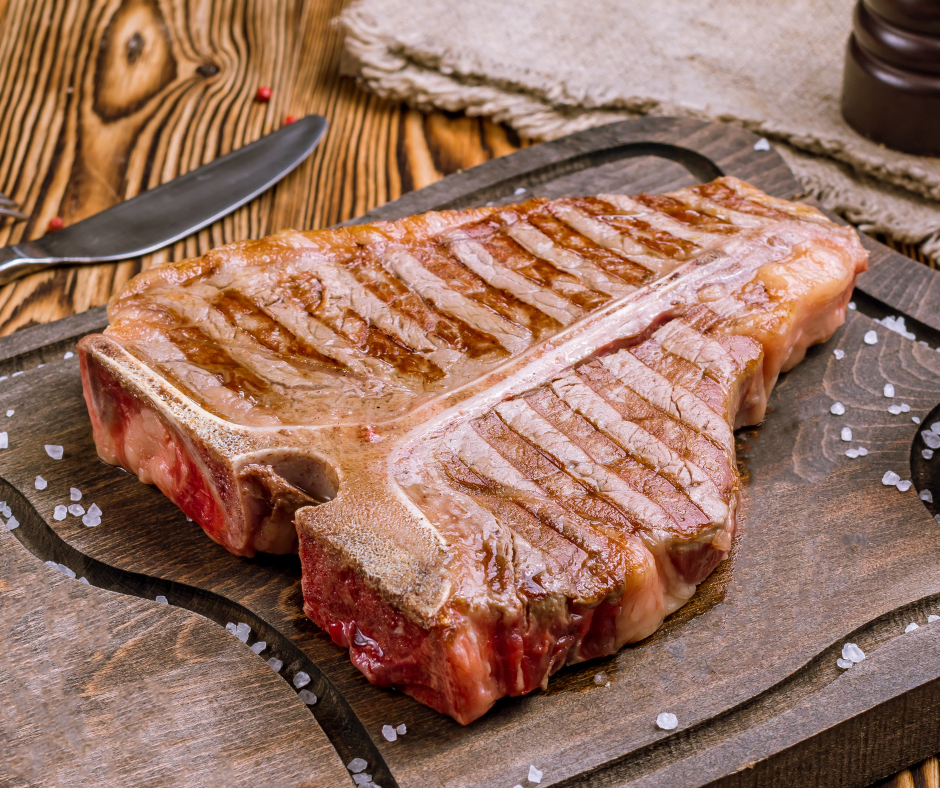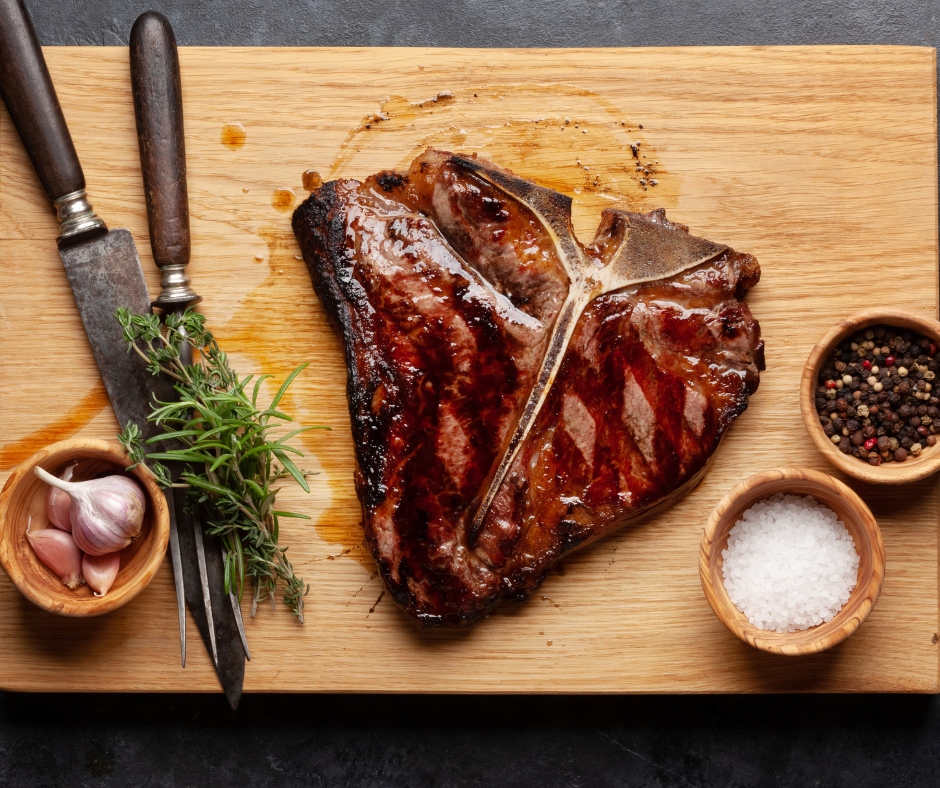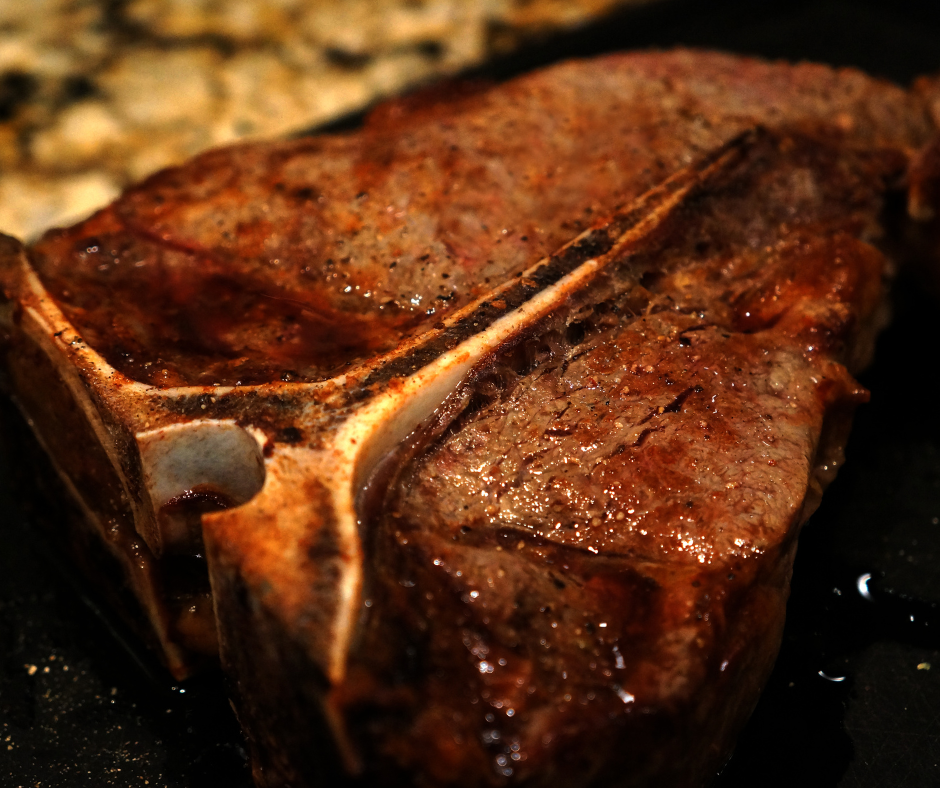Introduction
Overview Of T-bone And Porterhouse Steaks
Regarding steak cuts, the T-Bone and Porterhouse are two popular options that often confuse consumers. While many argue that there isn’t much difference when comparing T Bone vs Porterhouse, it’s important to understand the distinctions.
The T-Bone steak is cut from the short loin of the cow and gets its name from the T-shaped bone that runs through it. On one side of the bone, you’ll find a New York strip, and on the other side, a tenderloin filet. These two cuts are often separated and served individually. However, you have a T-bone steak when the filet and strip are left on the bone.
On the other hand, the Porterhouse steak is also cut from the short loin but is further back, closer to the sirloin. This means a Porterhouse steak includes a larger portion of the tenderloin than a T-bone steak. To be classified as a Porterhouse, the tenderloin portion should be at least 1.25 inches in diameter.
Differences Between T-bone And Porterhouse Steaks
The primary difference in comparing T Bone vs Porterhouse is their size rather than their taste or texture. The Porterhouse steak, having a larger tenderloin portion, is generally considered superior by steak enthusiasts. It offers a larger and more tender filet mignon section, making it ideal for those who prioritize tenderness.
In terms of cooking, both cuts can be prepared in the same way, whether it’s grilling, broiling, or pan-searing. However, due to its larger size, a Porterhouse steak may require more cooking time to ensure an even doneness throughout.
It’s also worth noting that the cost of these two steaks can vary. Generally, a Porterhouse steak is more expensive than a T-Bone steak because of its larger tenderloin portion. The grading of the steak, such as USDA Prime, can also affect the price.
Choosing Between T-bone And Porterhouse Steaks
When deciding between a T-Bone and Porterhouse steak, the choice primarily depends on personal preference and the number of people you plan to serve. If you feed a larger group, a Porterhouse steak is the better option due to its size and larger tenderloin portion. However, a T-Bone steak is usually sufficient if you cook for one or two people.
In conclusion, while the T-Bone and Porterhouse steaks share similarities, such as the T-shaped bone and the combination of New York strip and tenderloin, the Porterhouse offers a larger tenderloin portion. It is generally considered the more premium cut. Whether you opt for a T-Bone or a Porterhouse, both steaks are delicious and can be perfectly prepared with the right cooking technique.

T-bone Steak
T-bone Steak: Definition And Characteristics
The T-Bone steak is a popular and classic cut known for combining two different cuts of meat: the tenderloin and the strip steak. It gets its name from the T-shaped bone that runs through the center of the steak. On one side of the bone, you have the tender and lean tenderloin, also known as filet mignon, known for its melt-in-your-mouth tenderness. You have the flavorful and juicy steak on the other side of the bone, also known as the New York strip.
The T-Bone steak is typically cut from the short loin of the cow and offers a perfect balance of tenderness and flavor. It is known for its excellent marbling, contributing to its rich and beefy taste. The steak is often thick-cut, allowing for the perfect char on the outside while maintaining a tender and juicy interior.
T-bone Steak: Tenderloin And Strip Steak Ratio
One of the key differences between a T-bone steak and a Porterhouse steak is the ratio of tenderloin to strip steak. The tenderloin portion is smaller than the strip steak in a T-bone steak. This means you’ll get a larger piece of strip steak and a smaller piece of tenderloin when you order a T-bone.
The meat-to-bone ratio of a T-bone steak is relatively equal, with the bone accounting for approximately half of the steak’s weight. This gives the T-Bone steak a substantial and satisfying presence on the plate. The tenderness and flavor of the steak are evenly distributed, offering a delightful dining experience for steak lovers.
A T-bone steak is best prepared using high-heat methods such as grilling, broiling, or pan-searing. This allows for a delicious char on the outside while keeping the interior tender and juicy. Seasoned with simple salt and pepper or your favorite steak rub, a properly cooked T-Bone steak is a true gourmet delight.
In conclusion, the T-Bone steak is a classic steak cut that offers the best of both worlds – the tender and lean tenderloin and the flavorful strip steak. Although it has a smaller tenderloin portion than a Porterhouse steak, the T-Bone steak is still highly desirable for steak lovers. So, whether you’re grilling up a T-Bone or savoring a Porterhouse, you can’t go wrong with these delicious steak cuts.
Porterhouse Steak
Porterhouse Steak: Definition And Characteristics
The Porterhouse steak is a heavyweight contender in the world of steaks, known for its impressive size and mouthwatering taste. Like its counterpart, the T-Bone steak, the Porterhouse is cut from the short loin of the cow and shares similar characteristics, such as the T-shaped bone and a combination of fillet and strip steak.
What sets the Porterhouse steak apart is its size. It is renowned for its large and thick-cut nature, making it a favorite among meat lovers. The Porterhouse steak typically weighs around 24-48 ounces, with the bone accounting for a significant portion of its weight. This substantial cut allows for a hearty and satisfying meal.
The meat boasts exceptional marbling, contributing to its rich and beefy taste. The Porterhouse steak offers a perfect balance of tenderness and flavor, making it a top choice for those seeking a truly indulgent dining experience.
Porterhouse Steak: Tenderloin And Strip Steak Ratio
When comparing the Porterhouse steak to its counterpart, the T-Bone steak, one key difference lies in the ratio of tenderloin to strip steak. The Porterhouse steak boasts a larger tenderloin portion compared to the T-Bone steak. You’ll get a more substantial piece of tenderloin and a generous portion of strip steak when you order a Porterhouse.
The meat-to-bone ratio of the Porterhouse steak is significantly higher than that of the T-Bone steak, with a meat-to-bone ratio of around 3:1. This means you’ll be treated to a juicier and thicker fillet, offering a truly indulgent dining experience.
A Porterhouse steak is best prepared using high-heat methods such as grilling or broiling. The large size of the steak requires careful attention to cooking time and temperature to achieve the desired level of doneness. Seasoned with simple salt and pepper or your favorite steak rub, a perfectly cooked Porterhouse steak impresses even the most discerning steak connoisseurs.
In conclusion, the Porterhouse steak is the king of steaks, offering a larger tenderloin portion and a truly indulgent dining experience. Its impressive size and exceptional tenderness and flavor make it a top choice for meat lovers seeking a memorable meal. Whether you prefer the size and juiciness of the Porterhouse or the balance of flavors in the T-Bone, both cuts deliver a delicious and satisfying steak experience.

Differences When Comparing T Bone vs Porterhouse
Size And Thickness Of The Tenderloin
One of the key differences when comparing T Bone vs Porterhouse lies in the size and thickness of the tenderloin portion. Both steaks feature a T-shaped bone separating the tenderloin (the filet mignon) from the strip steak. However, the Porterhouse steak has a larger tenderloin portion than the T-Bone steak.
The tenderloin portion of the Porterhouse steak is significantly larger, offering a more substantial piece of filet mignon. This means that when you indulge in a Porterhouse steak, you’ll be treated to a generous serving of tender, melt-in-your-mouth beef. On the other hand, the T-Bone steak has a relatively smaller tenderloin portion compared to the Porterhouse.
Location Of The Cut On The Short Loin
Another difference between the T-Bone and Porterhouse steaks is the location of the cut on the short loin. The short loin is a cow section containing the T-Bone and Porterhouse steaks. However, the Porterhouse steak is cut from the rear end of the short loin, closer to the sirloin area, while the T-Bone steak is cut from the front end, closer to the rib area.
This difference in location affects the size and shape of the steaks. The Porterhouse steak tends to be larger and thicker, weighing around 24-48 ounces, with the bone accounting for a significant portion of its weight. On the other hand, the T-Bone steak is generally smaller and more moderate, making it suitable for individual servings or smaller appetites.
Despite these differences in size and location, the T-Bone and Porterhouse steaks offer a winning combination of flavors and textures. The shared characteristics, such as the T-shaped bone and the combination of tenderloin and strip steak, make both cuts a delight for steak lovers.
In conclusion, while the T-Bone and Porterhouse steaks share similarities, such as the same types of meat and the distinguishing T-shaped bone, there are notable differences between the two. The size and thickness of the tenderloin portion, as well as the location of the cut on the short loin, set the Porterhouse steak apart as a larger and more indulgent option. However, both steaks deliver a delicious dining experience with perfect tenderness and flavor.
Similarities Between T-bone And Porterhouse
T-shaped Bone And Meat On Each Side
When you compare T Bone vs Porterhouse steaks, one of the striking similarities is the presence of a T-shaped bone in the center. This bone separates two cuts of meat on each side of the steak. On one side of the bone is the tenderloin, also known as the filet mignon, and on the other is the strip steak. This unique structure combines flavors and textures, making both cuts highly sought after by steak enthusiasts.
Grilling And Cooking Methods
Another similarity between T-Bone and Porterhouse steaks is the versatility of cooking methods. These steaks can be cooked using various techniques such as grilling, broiling, or pan-searing. The high heat used in grilling or broiling helps to create a beautiful crust on the outside while retaining the juiciness and tenderness of the meat. Conversely, pan-searing allows for a more controlled cooking process, ensuring even heat distribution and optimal flavor development.
The recommended cooking time for T-Bone and Porterhouse steaks depends on the thickness and desired level of doneness. Thicker cuts may require a longer cooking time, while thinner cuts can be cooked relatively quickly. It is essential to use a meat thermometer to ensure the steak reaches the desired internal temperature for perfect doneness. Additionally, allowing the steak to rest for a few minutes after cooking helps to redistribute the juices and enhance the overall tenderness.
While T-Bone and Porterhouse steaks share these similarities, it is important to note their differences. The size and thickness of the tenderloin portion and the location of the cut on the short loin play a significant role in determining which steak is right for you.
In summary, T-Bone and Porterhouse steaks offer similar delicious flavors and textures, thanks to their T-shaped bone and combination of tenderloin and strip steak. Both cuts can be cooked using various methods for a mouthwatering dining experience.
However, understanding the differences, such as the tenderloin portion’s size and thickness and the cut’s location on the short loin, can help you decide between these popular steak cuts. Whether you prefer the larger and more indulgent Porterhouse or the smaller and more moderate T-Bone, both steaks will satisfy your cravings for a compelling and tender beef experience.

Conclusion
Now you should know how to compare T Bone vs Porterhouse. Both steaks offer a mouthwatering dining experience, with their tender and flavorful meat that is enhanced by the presence of the T-shaped bone. However, key differences between the two cuts should be considered when choosing.
Comparison Between T-bone And Porterhouse Steaks
T-Bone and Porterhouse steaks share many similarities. Both cuts are derived from the same portion of the beef, the short loin, which gives them a similar texture and tenderness. Additionally, both steaks feature a T-shaped bone running through the center, adding visual appeal to the dish.
However, there are distinct differences between the two cuts. The main difference when comparing T Bone vs Porterhouse lies in the size and thickness of the tenderloin portion. The Porterhouse steak has a larger tenderloin section than the T-Bone, making it a preferred choice for those who enjoy a generous filet mignon. On the other hand, the T-Bone offers a more balanced flavor profile, combining the smaller tenderloin and the strip steak.
Which One To Choose And When
The choice between T-Bone and Porterhouse steaks ultimately comes down to personal preference. If you prefer a larger cut with a generous portion of filet mignon, then the Porterhouse steak is the way to go. It is a decadent and indulgent choice that is perfect for special occasions or when you want to treat yourself.
On the other hand, if you prefer a more moderate portion size and a balance of flavors, the T-Bone steak is an excellent choice. It offers the perfect combination of tenderloin and strip steak, giving you a satisfying and flavorful dining experience.
It is also important to consider availability and cost when making a choice. Porterhouse steaks are often more expensive than T-Bone steaks due to the larger size of the tenderloin portion. Additionally, Porterhouse steaks may not be as readily available as T-Bone steaks in all steak restaurants.
In conclusion, while both T-Bone and Porterhouse steaks offer a mouthwatering dining experience, the key differences lie in their cost, size, and availability. Whether you prefer the generous filet mignon of a Porterhouse or the balanced flavors of a T-Bone, both cuts will satisfy any steak lover’s cravings. Understanding the key differences can help you make an informed decision based on your preferences. So, next time you’re at the butcher counter, choose the steak that best suits your taste and enjoy a delicious and satisfying meal.
FAQ: T Bone vs Porterhouse: Comparing Two Popular Steak Cuts
Q: What is the main difference when you compare T Bone vs Porterhouse?
A: The main difference lies in the proportion of tenderloin steak included in each cut. Porterhouse steaks are cut from the rear end of the short loin and, therefore, include more tenderloin steak. On the other hand, T-bone steaks are cut closer to the front and contain a smaller section of tenderloin.
Q: How can you distinguish between a T-bone and a Porterhouse steak?
A: According to the U.S. Department of Agriculture’s Institutional Meat Purchase Specifications, the tenderloin of a porterhouse must be at least 1.25 inches (32 mm) thick at its widest, while that of a T-bone must be at least 0.5 inches (13 mm). However, steaks with a large tenderloin are often called T-bones in restaurants and steakhouses, even if they technically qualify as porterhouse steaks.
Q: What are the other cuts of steak that come from the same area?
A: T-bone and Porterhouse steaks are cut from the short loin, part of the back of the cow. This cut yields other types of steak, such as the Kansas City Strip, New York Strip, and cuts that include partial meat from the tenderloin.
Q: Which cut contains more tenderloin, the T-bone or the Porterhouse?
A: The Porterhouse steak contains more of the tenderloin than the T-bone. The exact size and ratio may vary, but generally, Porterhouse steaks have a more generous amount of filet.
Q: Are there specific guidelines regarding the tenderloin size for each cut?
A: The USDA has guidelines for the tenderloin size in Porterhouse and T-bone steaks. The tenderloin of a porterhouse must be at least 1.25 inches (32 mm) thick, while the tenderloin of a T-bone must be at least 0.5 inches (13 mm) thick.
Q: Is there a difference in taste when comparing T Bone vs Porterhouse?
A: T-bone and Porterhouse steaks offer a combination of tenderloin and strip steak, resulting in a delicious and flavorful eating experience. The difference in taste may be subtle due to the variation in the amount of tenderloin, but both cuts are generally regarded as premium and highly enjoyable.
Remember, when ordering steak, it’s always a good idea to communicate your preferences to ensure you get the desired amount of tenderloin in your cut. Enjoy your steak!
Graham Bartlett, owner at Taco and Piña Mexican food, is all about bringing the authentic flavors of Mexico to your plate. With Graham Bartlett, you can tantalize your taste buds with mouthwatering tacos and delicious piña coladas, all in one place. Stay connected and never miss a beat as Graham Bartlett takes you on a culinary journey through vibrant Mexican cuisine. Join the community and discover the perfect blend of flavor, culture, and passion that Graham Bartlett brings to the table. Experience the essence of Mexico, one bite at a time, with Graham Bartlett.
